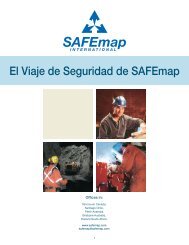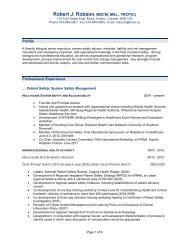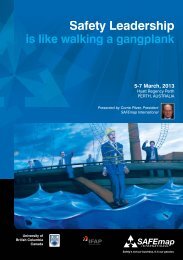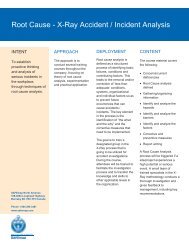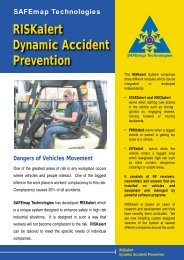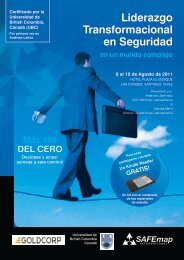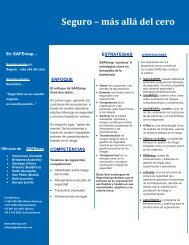A Matter of Perception - SAFEmap International
A Matter of Perception - SAFEmap International
A Matter of Perception - SAFEmap International
Create successful ePaper yourself
Turn your PDF publications into a flip-book with our unique Google optimized e-Paper software.
A perception survey measures how the people in the workplace perceive thesituation, it records what they believe to be true, it gauges opinion, outlookand attitude. In other words, it measures the "culture" or the operative realityin the workplace.Safety culture has the sound <strong>of</strong> one <strong>of</strong> those touchy-feely concepts that makeconsultants rich and the rest <strong>of</strong> us sigh or cringe. Dave Lafortune, who is asenior adviser for corporate health and safety with Ontario Power Generation,seems almost apologetic when he explains that safety culture has nothing todo with the high-sounding declarations <strong>of</strong> corporate principles that one <strong>of</strong>tenfinds framed and polished on corporate lobby walls.True versus real“ If I do my job the way that I was shown in training, and if I follow all the safetyrules, I will have no trouble meeting the production levels that are expected <strong>of</strong>me.” In your opinion, is this statement true? Score three for “always true”, tw<strong>of</strong>or “usually true”, one for “sometimes true” and zero for “never true”.The concept <strong>of</strong> corporate culture made wealthy men <strong>of</strong> folks like Tom Peters,Robert Waterman, Terrence Deal and Allan Kennedy, whose books defined itas the set <strong>of</strong> shared values and beliefs held by an organisation.It's a fuzzy concept, one that Pitzer says is difficult, maybe even impossible, tomeasure. What can be measured, he says, is how people behave, how theyperceive their own behaviour and how they perceive that <strong>of</strong> others. Somepeople call this "safety climate" rather than "safety culture" Whatever onechooses to call it, when Ontario Power Generation and the Australian miningindustry set out to understand the relationship between work and safety asseen by the workers themselves, they did so by using perception surveys.It's difficult to tell to what extent companies are looking at safety culture aspart <strong>of</strong> their corporate safety initiatives. It's still a new concept. Broadorganization-wide surveys <strong>of</strong> corporate perceptions have been around sinceat least the 1980s, says Pitzer, but the results <strong>of</strong> those surveys have givenlittle <strong>of</strong> value to safety managers. The narrowly focused safety culture surveyis a much newer addition to the safety manager's tool kit, and Ontario PowerGeneration and the Australian mining industry are among the few who daredto use it.There are others, <strong>of</strong> course, who have looked or who will soon be looking atsafety culture but who are reluctant to talk about it. It's not difficult tounderstand why. Corporate culture, mission statements, statements <strong>of</strong> corevalues and similar pronouncements have become part <strong>of</strong> a corporation'spublic face. Corporations use them to define themselves to the outside world.Heather Harvey, director <strong>of</strong> human resources and environmentalmanagement at the Woodbridge Group, says her employer prefers to spendits time talking about safety culture and reinforcing it rather than surveying it."Culture is seen in the way in which we behave and in the attitudes we haveas individuals and in groups throughout the organization," she says.



